| |
 
SECRET
VILLAGES OF THE SOUTH DOWNS
 |
|
Huddled around the
largest Bronze Age long barrow in Sussex,
in glorious countryside north-west of
Chichester, are the Mardens. There are
four of them, North, East, West and Up,
and they’ve been there for
centuries. What is more, despite being
only ten miles from the sprawl of
Portsmouth, three of them have hardly
changed. Today’s cottages may be
built of flint and the farms sport an
occasional Dutch barn, but the landscape
is much as it was six, seven, eight
hundred years ago. |
| People have lived
here for thousands of years, and the
barrow, called Bevis’s Thumb, stands
at the foot of Telegraph Hill. It is 210
ft. long, obviously the burial place of
some very important prehistoric man.
During the Middle Ages a legend grew that
it was the grave of the giant Sir Bevis
of Hampton. Hampton may be Southampton,
but Bevis is usually linked with Arundel,
owing to the name of his horse,
Hirondelle. He is said to have thrown his
sword, Morglay, from the battlements of
Arundel Castle to mark the place of his
burial. Some giant! There are other
ancient burial sites on North Marden
Down. |
|
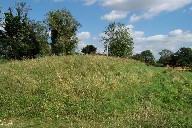 |
The Romans came to these
parts as well, as we know from the palace at
Fishbourne, and at Watergate Hangar, near West
Marden, another Roman Villa has been excavated.
Originally a simple three-roomed cottage, it was
later enlarged, and pottery found at the site
indicates that it was occupied between the 2nd
and the 4th centuries.
Christianity came early, with missionaries
penetrating the dense forests to convert the
remote pagan settlements. Their churches would
have been made of wattle and daub, but were
rebuilt of flint both before and after the Norman
conquest, and these are the churches that stand
today in three of the villages.
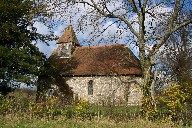 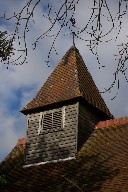 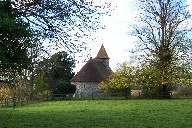
The earliest is St.
Mary’s at North Marden, standing in a
farmyard well back from the Petersfield –
Chichester road. It was founded in the 12th
century by Geoffrey, son of Azo, and its walls
remain virtually untouched - just a single room,
with a semi-circular east end, one of only four
in the whole of England. The notable Norman south
door stands protected by a Victorian porch.
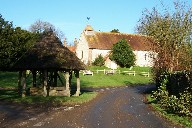 |
|
|
|
St. Richard of
Chichester would have known this church
when he passed through the Mardens. He is
said to have performed a minor miracle
hereabouts, when, in answer to the
prayers of the villagers during a
drought, he provided a spring of cold,
clear water. Could this be the origin of
the thatched well, which forms a landmark
in the centre of East Marden to this
day?St. Peter’s Church all dates
from the 13th century, and contains a
beautiful little organ which once
belonged to Prince Albert, who often
played it at St. James’s Palace. |
But the gem of the Mardens
is St. Michael’s at Up Marden, 500 ft. up on
the ridge and completely hidden from the lane.
Though it has hardly changed since it was built
in the 13th century, it found fame in 1965, when
Ian Nairn wrote enthusiastically about it in the
Sussex volume of Pevsner’s Buildings of
England series. He called it one of the loveliest
interiors in England, the slow, loving, gentle
accretion century by century, until it is
something as organic as the South Downs
themselves.
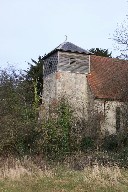 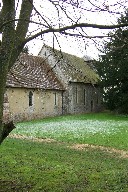 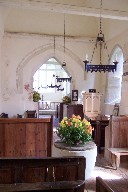 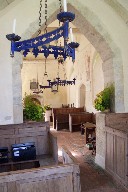
Indeed, the little
weather-boarded tower seems to grow out of the
surrounding trees and the whole place is
incredibly moving whether one is Anglican or not,
whether one is Christian or not. More recently
the columnist Simon Jenkins has enthused about it
in The Times and in his book England’s
Thousand Best Churches. The love and affection in
which all these churches are held reflects
enormous credit on the incumbents and the
parishioners, who obviously care so much about
them. The population of these places has hardly
changed since records began. North Marden had
twenty souls in 1971, and can hardly have
increased.
Although East Marden had a shop and a school
between the two World Wars, the main centre of
population now seems to be West Marden. Alone of
the four villages, here we find main road
traffic, a dining pub and even a building site,
all symbols of the present day. Also alone of
these villages, there is no church, though the
Victoria County History suggests that there may
once have been a chapel here.
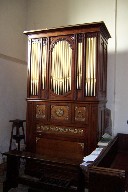 |
|
Those lucky enough
to know the Mardens won’t forget
them in a hurry. They still exude peace
and tranquillity, and might well have
been the object of Kipling’s
affection a hundred years ago when he
wrote: Here
through the strong and shadeless days
The tinkling silence thrills;
Or little, lost, Down churches praise
The Lord who made the hills.
|
Tom Muckley, November 2003
This article was originally
published by the
Petersfield Post
tommuckley.co.uk
|
|












